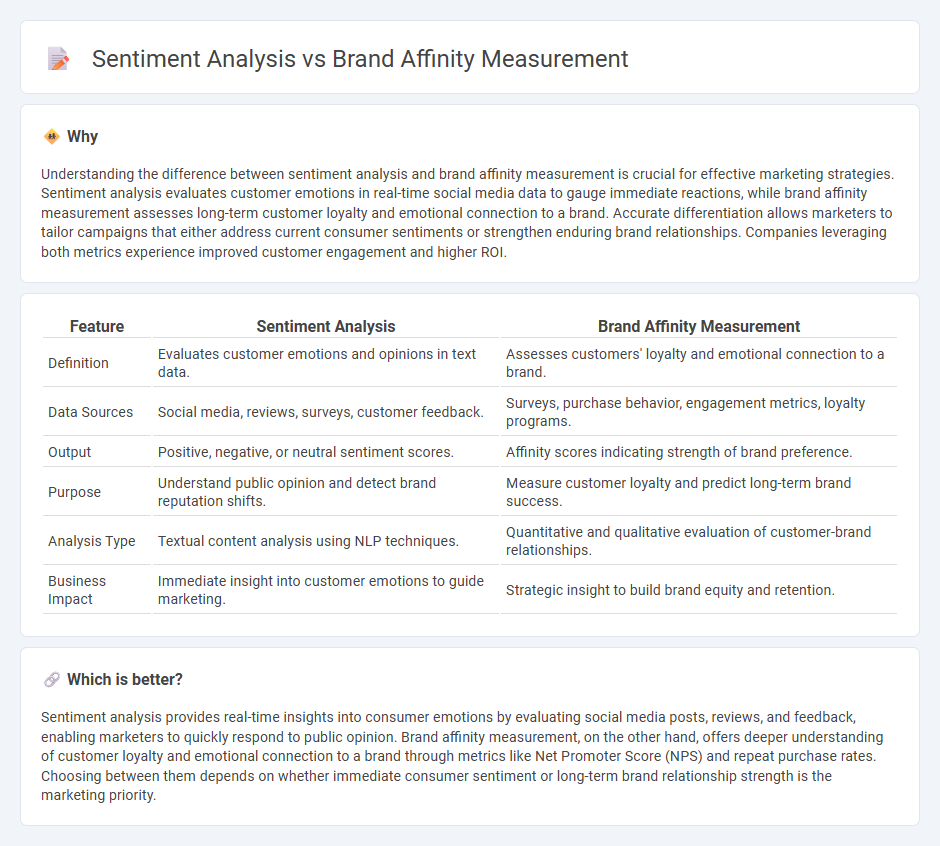
Sentiment analysis evaluates customer emotions by analyzing text data from social media, reviews, and surveys to determine positive, negative, or neutral feelings toward a product or brand. Brand affinity measurement quantifies the strength of consumer preference and loyalty based on engagement metrics, repeat purchases, and brand interactions. Explore these tools further to enhance your marketing strategy and deepen customer relationships.
Why it is important
Understanding the difference between sentiment analysis and brand affinity measurement is crucial for effective marketing strategies. Sentiment analysis evaluates customer emotions in real-time social media data to gauge immediate reactions, while brand affinity measurement assesses long-term customer loyalty and emotional connection to a brand. Accurate differentiation allows marketers to tailor campaigns that either address current consumer sentiments or strengthen enduring brand relationships. Companies leveraging both metrics experience improved customer engagement and higher ROI.
Comparison Table
| Feature | Sentiment Analysis | Brand Affinity Measurement |
|---|---|---|
| Definition | Evaluates customer emotions and opinions in text data. | Assesses customers' loyalty and emotional connection to a brand. |
| Data Sources | Social media, reviews, surveys, customer feedback. | Surveys, purchase behavior, engagement metrics, loyalty programs. |
| Output | Positive, negative, or neutral sentiment scores. | Affinity scores indicating strength of brand preference. |
| Purpose | Understand public opinion and detect brand reputation shifts. | Measure customer loyalty and predict long-term brand success. |
| Analysis Type | Textual content analysis using NLP techniques. | Quantitative and qualitative evaluation of customer-brand relationships. |
| Business Impact | Immediate insight into customer emotions to guide marketing. | Strategic insight to build brand equity and retention. |
Which is better?
Sentiment analysis provides real-time insights into consumer emotions by evaluating social media posts, reviews, and feedback, enabling marketers to quickly respond to public opinion. Brand affinity measurement, on the other hand, offers deeper understanding of customer loyalty and emotional connection to a brand through metrics like Net Promoter Score (NPS) and repeat purchase rates. Choosing between them depends on whether immediate consumer sentiment or long-term brand relationship strength is the marketing priority.
Connection
Sentiment analysis evaluates customer emotions and opinions expressed in text data, providing insights into public perception of a brand. Brand affinity measurement quantifies the strength of emotional connection and loyalty consumers feel towards a brand. Combining sentiment analysis with brand affinity measurement enables marketers to identify positive or negative sentiment patterns that directly influence consumer attachment, enhancing targeted marketing strategies and customer relationship management.
Key Terms
Brand Affinity Measurement:
Brand affinity measurement quantifies the emotional connection and loyalty customers feel towards a brand, using metrics like repeat purchase rate, net promoter score (NPS), and customer lifetime value (CLV). Unlike sentiment analysis that evaluates public opinion or social media sentiment for specific mentions, brand affinity focuses on deeper, ongoing customer relationships and brand preference over competitors. Discover more about leveraging brand affinity measurement to build stronger customer loyalty and enhance strategic marketing initiatives.
Net Promoter Score (NPS)
Brand affinity measurement quantifies customer loyalty and emotional connection to a brand, often using metrics like Net Promoter Score (NPS) to gauge the likelihood of recommending the brand to others. Sentiment analysis evaluates customers' expressed opinions and emotions in text data to understand positive, neutral, or negative feelings towards a brand or product. Explore how integrating NPS-driven brand affinity with sentiment analysis can provide deeper insights into customer experience and loyalty.
Brand Loyalty
Brand affinity measurement quantifies customer attachment and preference toward a brand, emphasizing long-term loyalty and repeat purchase behavior, while sentiment analysis assesses emotions expressed in customer feedback, highlighting immediate positive or negative reactions. Measuring brand affinity involves tracking metrics such as Net Promoter Score (NPS) and Customer Lifetime Value (CLV), which reflect how deeply consumers connect with a brand beyond transient feelings captured by sentiment analysis tools. Explore how integrating brand affinity measurement with sentiment insights can enhance brand loyalty strategies and customer retention.
Source and External Links
A Comprehensive Guide: Measuring Brand Affinity - Brand affinity is measured through surveys, digital monitoring (like content interaction and web analytics), and customer reviews to track customer feelings and improve marketing strategies over time.
Brand Affinity Guide: What Is It & How to Build It - Key brand affinity metrics include time spent consuming content, customer lifetime value, referrals, search volume, and social media mentions, which indicate customer engagement and emotional connection to a brand.
What Is Brand Affinity and How Do You Increase It? - Brand affinity can be measured using net promoter score (NPS), social listening, surveys on emotional connection, repeat purchases, referral counts, user-generated content, and customer lifetime value as indicators of loyalty and preference.
 dowidth.com
dowidth.com